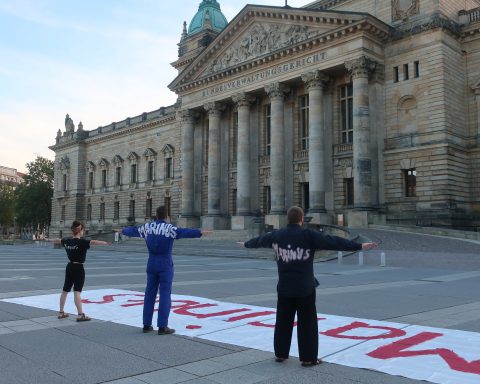I suppose I had no choice but to become interested in climatology. When I was a child, it was one of my father’s daily rituals to check the thermometer twice a day. On his way he would walk past a green transparent cylinder with engraved markings on it (better known as a rain gauge), carefully inspecting the amount of water that had accumulated in it, spilling the substance on the lawn. Next he’d lick his finger and hold it up in the air for a few seconds. As a child I found my father’s rituals somewhat bewildering of course, and I understood only later that he was trying to record the climate of Großpösna, the village where I grew up. Every day he would then open a booklet and write down the following data: maximum temperature (°C), minimum temperature (°C), precipitation (mm), wind direction, wind speed (Beaufort) and average cloud coverage. My dad began these recordings in 1980 and he continues them to this day, albeit digitally.
At age 13 I decided that I would convert my father’s entire dataset to an Excel-chart, which would then allow me to draw conclusions on the evolution of Großpösna’s climate. I was dealing with over 20,000 individual data points so this was no easy task. Nevertheless, my curiosity was finally victorious.
Now I held it in my hands – proof of the story that NGOs, media and politicians were beginning to tell us: The Earth was getting warmer. If you have spent July 2015 in Leipzig you may have noticed that temperatures have almost continuously ranged between 25-35°C.* Please be aware that this is totally unusual. The temperature anomaly for this year’s July is likely to be at least 3.5K** above average (22°C), which made this month only slightly cooler than Venice’s average July. In fact, July is merely one in a long series of excessively warm months that has characterised the last couple of years. Out of the last 28 months, only two were too cool. With an average temperature of 11.2°C (as opposed to 9.2°C during a normal year) 2014 was the warmest year since 1934, and it appears that there is a good chance that 2015 will be even warmer.
Leipzig’s climate is changing. While the city will continue to lie in the transition zone of Western Europe’s oceanic climate (characterised by mild winters and relatively cool summers) and Eastern Europe’s continental climate (cold winters and hot summers), one of the most visible changes concerns temperature. Over the last 50 years, temperatures in Leipzig have increased by approximately 1.2K, which is slightly above the global average. 9 of the 20 warmest years since 1901 have occurred after 1990. There has been an increase in weather extremes (especially storms), annual precipitation has become significantly higher and more concentrated (thunderstorms), there have been longer phases of drought, wind direction has changed towards the south-west and the fertile period has been extended. At the same time snowfall has decreased and winters have become warmer.

You may have lived in Leipzig in 2012 and 2013, remembering that temperatures occasionally dropped to -25°C – these were outliers. The overall trend is going in one direction only. As opposed to my father, I won’t be able to tell my kids stories of snow reaching up to the top of the fences.
Probably you love it. With lakes, parks and ice cream parlours all over the city, summer easily becomes one’s favourite season. And I also don’t mind paying less for my gas bill after a mild winter. However, indigenous plants and animals are beginning to struggle. After the elm blight of the 20th century, which killed off the vast majority of Europe’s elm trees, other species too are being threatened. The Norway spruce for example, which currently covers large parts of Southern Saxony, is likely to become rare within the century, eventually going extinct. Several species of birds that were common during my childhood have disappeared (e.g. the Bohemian waxwing). There are now cases of tiger mosquitos becoming indigenous to Germany. These little beasts carry within them the pathogens causing Chikungunya, dengue fever and yellow fever.
So, climate change hasn’t been on the news much lately, but it is happening, and its consequences are becoming increasingly visible. Now, I guess it seems silly to remind you to be more conscious of the effects of your lifestyle on our climate. Nevertheless, I would encourage you to be more conscious of weather phenomena and their climatological context. CO2 now constitutes 0.04% of our atmosphere, up from 0.025% before industrialisation. This has caused the most rapid climate change event in the history of humanity. When you have drinks on Karli during a hot summer night, when you can go sunbathe at Cospudener See every day for three weeks straight, when you can’t sleep without a fan to keep you cool – keep in mind that you’re watching a disaster unfold.
*For my American friends: 0°C is equivalent to 32°F, while 38°C is roughly equivalent to 100°F. Anything above 30°C (i.e. 86°F) is considered a ‘hot day’.
**Kelvin (K) is the standard unit for measuring temperature. 1K is equivalent to precisely 1°C. The Kelvin scale begins at absolute zero, which means that 0K is the same as -273°C or roughly -460°F.









